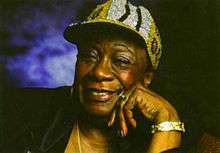Irene Reid

Irene Reid (September 23, 1930 – January 4, 2008)[1] was an American jazz singer.
Reid was born and raised in Savannah, Georgia. She sang in church and in high school in Georgia, and moved to New York City in 1947 after her mother died. Toward the end of 1947, she tried out for an amateur contest at the Apollo Theater in Harlem, and won the competition for five straight weeks. Soon after she was offered a slot as the featured vocalist with Dick Vance at the Savoy Ballroom, which she held from 1948 to 1950.
In 1961–62, Reid sang with Count Basie's orchestra, and recorded for Verve Records. Her debut for Verve, Room For One More (1965), arranged and conducted by Oliver Nelson and engineered by Rudy Van Gelder, featured many of the leading musicians of the day: Charlie Mariano, Jerome Richardson, Phil Woods, Jerry Dodgion, Thad Jones, Joe Newman, Jimmy Cleveland, Urbie Green, J.J. Johnson, Kenny Burrell, Bob Cranshaw, Roger Kellaway and Grady Tate.[2][3]
Two Buddy Johnson classics are featured among a memorable program. Both “Save Your Love For Me" and “I Wonder Where Our Love Has Gone" find Reid belting out an emotionally charged message with perfect intonation and just the right touch of reverb provided by the eminent . She later performed in a Broadway production of the musical The Wiz. Additionally, she sang with Carmen McRae, Sarah Vaughan, Aretha Franklin, and B.B King. Reid receded from fame in the 1970s and 1980s, but launched a comeback near the end of that decade. She appeared at the Savannah Jazz Festival in 1991, 1994, and 1996, and continued releasing albums on Savant Records in the 1990s and 2000s.
In 2002, one of Reid's songs "I Must Be Doing Something Right" was sampled in the song "Reckless Girl" by The Beginerz. The song can be found on the compilation album Hits 53.
Discography
- It's Only the Beginning for Irene Reid (MGM Records, 1963)
- Room for One More (Verve Records, 1965)
- It's Too late (Verve, 1966)
- A Man Only Does (What a Woman Makes Him Do) (Verve, 1967)
- I've been here all the time (Barry)
- The World Needs What I Need (Polydor Records, 1971)
- Two Of Us (Glades Records, 1976)
- The Lady from Savannah (Birdland Records, 1989)
- Thanks to You (Inspire, 1991) Dedicated to her grandson Rodney S Reid
- Million Dollar Secret (Savant Records, 1997)
- I Ain't Doing Too Bad (Savant, 1999)
- The Uptown Lowdown (Savant, 1999)
- Movin' Out (Savant, 1999)
- One Monkey Don't Stop No Show (Savant, 2001)
With Count Basie
- Back with Basie (Roulette, 1962)
- Basie in Sweden (Roulette, 1962)
References
- ↑ Obituary Jazz Foundation of America. Retrieved 20 April 2013.
- ↑ Obituary News All About Jazz. Retrieved 20 April 2013.
- ↑ Overview allmusic. Retrieved 20 April 2013.